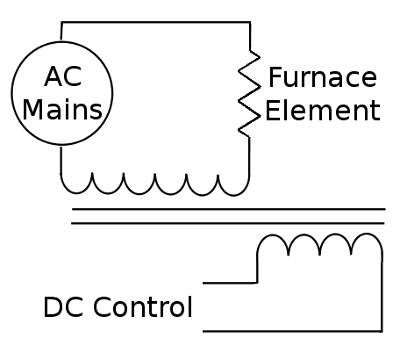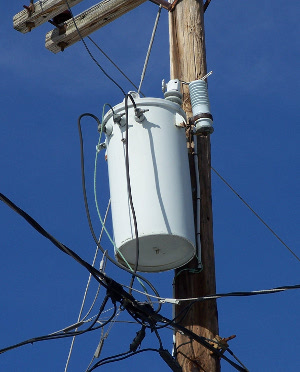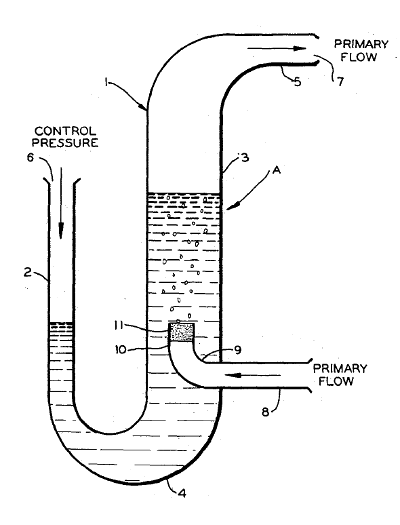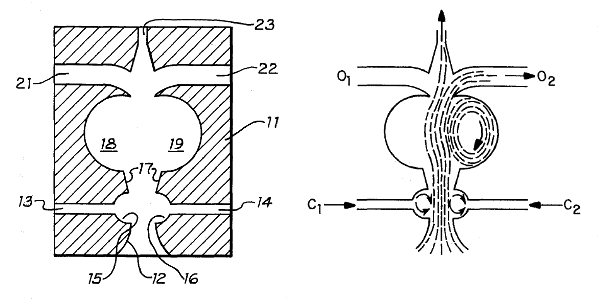Unusual Amplifiers
April 20, 2011
When I was a graduate student, my
experimental work involved
differential scanning calorimetry of the
reactions of
metals forming
alloys. My apparatus was a
vacuum chamber with an internal electric
furnace that allowed heating of
gram-sized powder mixtures to very high
temperature. Of course, there were no commercially-available instruments that were capable of what I wanted to do, so I had to build my own.
Actually, if commercial units were available, I still would have needed to build my own, since the university and our funding agencies weren't about to put-up the money. At one point, I didn't even have enough money to buy
liquid nitrogen, which I needed for some experiments. I did a
barter for some with another project that needed me to build an
electronic control circuit.
I struggled for a time with a primitive
temperature controller for the furnace, but I finally gave up on that and built my own. These were the days before high power
thyristors, such as
SCRs and
triacs, were readily available; so power-handling of the
kilowatts needed for such furnaces was typically relegated to high power
relays, also called
contactors. Contactors are suitable only for crude,
"bang-bang," control, which wasn't accurate enough for my experiments. I was fortunate to have a better solution, a
saturable-core reactor.
This reactor, which was actually a large
inductor with a slight modification, was heavy and huge. It was about two cubic feet in volume and almost a hundred pounds in weight. It had two, high
current, terminals that connected in series with the
resistance heating element of the furnace, and another two terminals that connected to my controller. The reactor was essentially a
current amplifier that took a few
milliamps from my controller and converted it into tens of
amps for the furnace; and its operating principle was quite simple.
An inductance impedes the flow of
alternating current, and practical inductors at low frequencies, like the 60
Hz AC power line, need a
magnetic core to have a large inductance. The magnetic core material, typically
silicon steel, increases the inductance of several turns of wire by a factor of hundreds; sometimes, thousands. Of course, the core must be magnetic for this to be true, and magnetic materials will
saturate when too high a
magnetic field is applied.
When saturated, an inductor core will not act to increase the inductance of the wire turns, and the inductance will go from a very high to a very low value. A small
DC current in a control winding of many turns around the core will saturate it, and thereby control the inductance. This controls the current flow though the AC winding.

Saturable core reactor as used in my furnace control system. A small current in the control winding affects the current in the main winding)
My saturable core reactor was a example of a what's called a
magnetic amplifier. Such devices were common for power handling applications before thyristors and
transistors, and they were also useful in applications for which
vacuum tubes would be too fragile. For this reason, they were used in the
German V-2 rockets during
World War II, and they were used in
avionic systems, for which
reliability is essential.
Since an inductor is
frequency selective, you wouldn't think such amplifiers would have much use. To circumvent such a limitation, a high frequency
carrier wave, followed by a
detector, in analogy to an
AM transmitter and
radio receiver combination, was used to make
wideband magnetic amplifiers.
Magnetic amplifiers are not the only unusual amplifier technology.
Fluidics is another. Yes, you can make a fluid amplifier, which is not surprising when you consider that the first page of nearly every electronics textbook makes the analogy between fluids, voltage and current. After all, current is the flow of electrons, and my father always called electricity, "juice." When I was really young, I thought those big canisters on
utility poles were there to store this "juice."

Careful what you tell children! These don't really contain juice (see text).
Photo by author
Don't think that fluidics is something from the time before vacuum tubes became reliable. Although dreadfully slow compared with electronics, fluidics has advantages in applications where no electronics could survive,[3] and the rise of
nanotechnology makes fluidics an interesting topic for revival. Some fluidic device were designed to be analogues of electronic devices, such as the fluidic
triode shown below.[4]

Figure one of U.S. Patent No. 3,455,326, "Fluid Triode."[4])
The operation of the fluidic triode is easily understood. The fluid flow is through a
frit at (11) that's immersed in a liquid.
Pressure of the control fluid above the frit, which is related to the level of the control fluid, impedes fluid flow from the input port (8) to the output port (5). The level of the control fluid is adjusted by a control pressure (6). A very dense fluid, such as
mercury, can be used. One disadvantage is that this triode must be kept in an upright position.
A fluidic amplifier is shown in the figure below.[5] It's operation is somewhat more difficult to understand than the fluidic triode. In the triode, it was
pressure that modulated the fluid flow, but a control flow acts as the modulator in this device. Flow in the control ports, combined with the presence of the cavities in the device, steers the main fluid flow to one port, or another. This is descibed in a very concise
patent, so I refer you to the explanations in its text.[5] This device is claimed to have a
gain of at least ten, and you could
cascade these for higher gain.

Figures from U.S. Patent No. 4,000,757, "High gain fluid amplifier."[5]
References:
- George Trinkaus, editor, "Magnetic Amplifiers: Another Lost Technology," Electronics Design and Development Division, Bureau of Ships, United States Navy, 1951.
- George Trinkaus, "The Magnetic Amplifier: A Lost Technology of the 1950s," Nuts & Volts, vol. 27, no. 2 (February 2006), pp.68-71.
- G. Raman, S. Packiarajan, G. Papadopoulos, C. Weissman and S. Raghu, "Jet thrust vectoring using a miniature fluidic oscillator," The Aeronautical Journal (March 2005), pp.129-138.
- Gene E. Lightner, "Fluid Triode," U.S. Patent No. 3,455,326, July 15, 1969.
- Peter A. Freeman, "High gain fluid amplifier," U.S. Patent No. 4,000,757, January 4, 1977.
Permanent Link to this article
Linked Keywords: Experiment; experimental; differential scanning calorimetry; chemical reaction; metal; alloy; vacuum chamber; furnace; gram; temperature; liquid nitrogen; barter; electronic control circuit; temperature controller; thyristors; silicon-controlled rectifier; SCR; triac; kilowatt; relay; contactor; bang-bang control; saturable-core reactor; inductor; electrical current; resistance heating element; current amplifier; milliampere; ampere; alternating current; Hertz; Hz; mains electricity; AC power line; magnetic core; silicon steel; magnetic saturation; magnetic field; direct current; DC; magnetic amplifier; transistor; vacuum tube; German V-2 rocket; World War II; avionic systems; reliability; frequency; carrier wave; detector; AM transmitter; radio receiver; wideband; fluidics; utility pole; nanotechnology; triode; U.S. Patent No. 3,455,326; frit; hydraulic head; mercury; pressure; patent; gain; cascade; U.S. Patent No. 4,000,757.